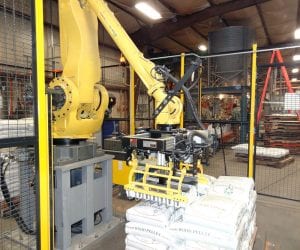In the immortal words of William Shakespeare (and taking a little poetic license), “To  automate or not to automate, that is the question.” That is, if he was still alive today, that’s probably what he’d be asking.
automate or not to automate, that is the question.” That is, if he was still alive today, that’s probably what he’d be asking.
A growing number of warehousing operations and manufacturers are considering automation. There are numerous reasons for this, including increasing competition, the soaring demand for eCommerce and faster shipping, labor challenges, and social distancing requirements. Many companies have already invested in some form of automation, and this trend shows no signs of slowing down.
No matter the industry, application or complexity, here is a simple guide to automation that even William Shakespeare could understand. Let’s start with the pros and cons of using people versus machines.

Now, let’s drill down into each of these categories a little further.
- Accuracy – People will tend to deviate from a repetitive task for various reasons.
-
- Tired
- Bored
- Physical fatigue
- Mood
- Machines will not deviate from repetitive tasks, achieving low error rates.
- Speed – People will slow down as the day wears on, but machines will keep a steady programmed pace of productivity.
- Cost – People are a forever cost. You will pay them every year, whereas automation is a one-time cost plus yearly maintenance costs and generally pay for themselves quickly.
- Scalability – Both can be added to. However, with the labor market as volatile as it is today, sometimes you can’t fill that need with qualified personnel.
- Flexibility to change function – People, for the most part, can be trained to accomplish other tasks, whereas automation is more limited but can be reprogrammed.
- Reliability – Automation doesn’t call in sick, quarantine, go on vacation or strike, ask for a raise, need medical leave, take workman’s comp, or require retirement benefits.
Automation Empowers
In addition to these benefits, automation also improves safety, efficiency, and  ergonomics. It’s ideal for physically demanding and monotonous jobs that can lead to turnover or potential injuries. Automation allows businesses to reallocate or reduce labor in their operations. It also minimizes the cost of labor turnover, all giving a boost to your bottom line.
ergonomics. It’s ideal for physically demanding and monotonous jobs that can lead to turnover or potential injuries. Automation allows businesses to reallocate or reduce labor in their operations. It also minimizes the cost of labor turnover, all giving a boost to your bottom line.
So, to sum up the question, “to automate or not to automate,” it’s clear there are many compelling reasons to take a serious look into automation. With the help of an experienced automation specialist and a specialist for all automation choices like Abel Womack, we’ll help you make the best decisions for your specific business needs.



Leave a Reply
You must be logged in to post a comment.